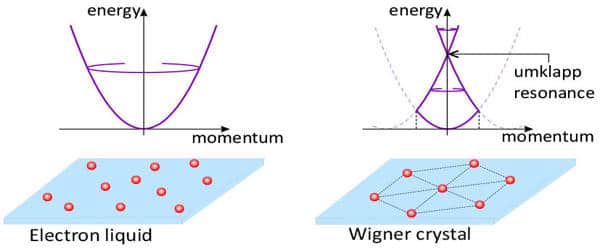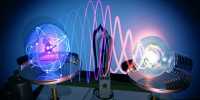Researchers at ETH Zurich have observed a crystal made entirely of electrons. Such Wigner crystals were predicted nearly ninety years ago but could not be observed directly in a semiconductor material until now.
Crystals have captivated people throughout history. Who hasn’t marveled at the intricate patterns of a snowflake or the perfectly symmetrical surfaces of a rock crystal? Even if one understands that all of this is due to a simple interplay of attraction and repulsion between atoms and electrons, the magic continues.
A team of researchers led by Ataç Imamolu, professor at ETH Zurich’s Institute for Quantum Electronics, has created a very special crystal. It is made entirely of electrons, as opposed to normal crystals. They have thus confirmed a theoretical prediction made nearly ninety years ago, which has since been regarded as a kind of holy grail of condensed matter physics. Their findings were recently published in the prestigious scientific journal Nature.
Researchers have succeeded in observing a crystal that consists only of electrons. Such Wigner crystals were already predicted almost ninety years ago but could only now be observed directly in a semiconductor material.
A decades-old prediction
“What drew us to this problem was its simplicity,” Imamolu says. Eugene Wigner, one of the founders of the quantum mechanics theory of symmetries, demonstrated in 1934 that electrons in a material could theoretically arrange themselves in regular, crystal-like patterns due to their mutual electrical repulsion. The reasoning is straightforward: if the energy of electrical repulsion between electrons is greater than their motional energy, they will arrange themselves so that their total energy is as low as possible.
This prediction, however, remained purely theoretical for several decades because “Wigner crystals” can only form under extreme conditions such as low temperatures and a very small number of free electrons in the material. This is due, in part, to the fact that electrons are many thousands of times lighter than atoms, which means that their emotional energy in a regular arrangement is typically much greater than the electrostatic energy caused by electron interaction.

Electrons in a plane
To overcome these challenges, Imamolu and his colleagues used a wafer-thin layer of the semiconductor material molybdenum diselenide that is only one atom thick and thus only allows electrons to move in a plane. The researchers were able to control the number of free electrons by applying a voltage to two transparent graphene electrodes sandwiching the semiconductor. The electrical properties of molybdenum diselenide, according to theoretical considerations, should favor the formation of a Wigner crystal—provided that the entire apparatus is cooled to a few degrees above the absolute zero of minus 273.15 degrees Celsius.
However, simply creating a Wigner crystal is insufficient. “The next problem was demonstrating that we actually had Wigner crystals in our apparatus,” says Tomasz Smoleski, the publication’s lead author and a postdoc in Imamolu’s laboratory. The electron separation was calculated to be around 20 nanometres, or roughly thirty times smaller than the wavelength of visible light, and thus impossible to resolve even with the best microscopes.
Detection through excitons
The physicists used a trick to make the regular arrangement of electrons visible despite the small separation in the crystal lattice. To do so, they used a specific frequency of light to excite excitons in the semiconductor layer. Excitons are pairs of electrons and “holes” caused by a missing electron in a material’s energy level. The precise light frequency for the generation of such excitons, as well as their speed, are determined by the material’s properties as well as their interaction with other electrons in the material—for example, with a Wigner crystal.
The periodic arrangement of electrons in the crystal produces an effect that can be seen on television from time to time. When a bicycle or a car accelerates, the wheels appear to stop and then turn in the opposite direction above a certain speed. This is due to the camera taking a picture of the wheel every 40 milliseconds. If the wheel’s regularly spaced spokes have moved by exactly the distance between the spokes during that time, the wheel appears to no longer turn. Moving excitons appear stationary in the presence of a Wigner crystal if they are moving at a certain velocity determined by the separation of the electrons in the crystal lattice.
First direct observation
“A group of theoretical physicists led by Eugene Demler of Harvard University, who is moving to ETH this year,” Imamolu says, “had calculated theoretically how that effect should show up in the observed excitation frequencies of the excitons—and that’s exactly what we observed in the lab.” Unlike previous experiments based on planar semiconductors, which observed Wigner crystals indirectly through current measurements, this is a direct confirmation of the regular arrangement of electrons in the crystal. Imamolu and his colleagues hope to investigate how Wigner crystals form from a disordered ‘liquid’ of electrons in the future using their new method.
















